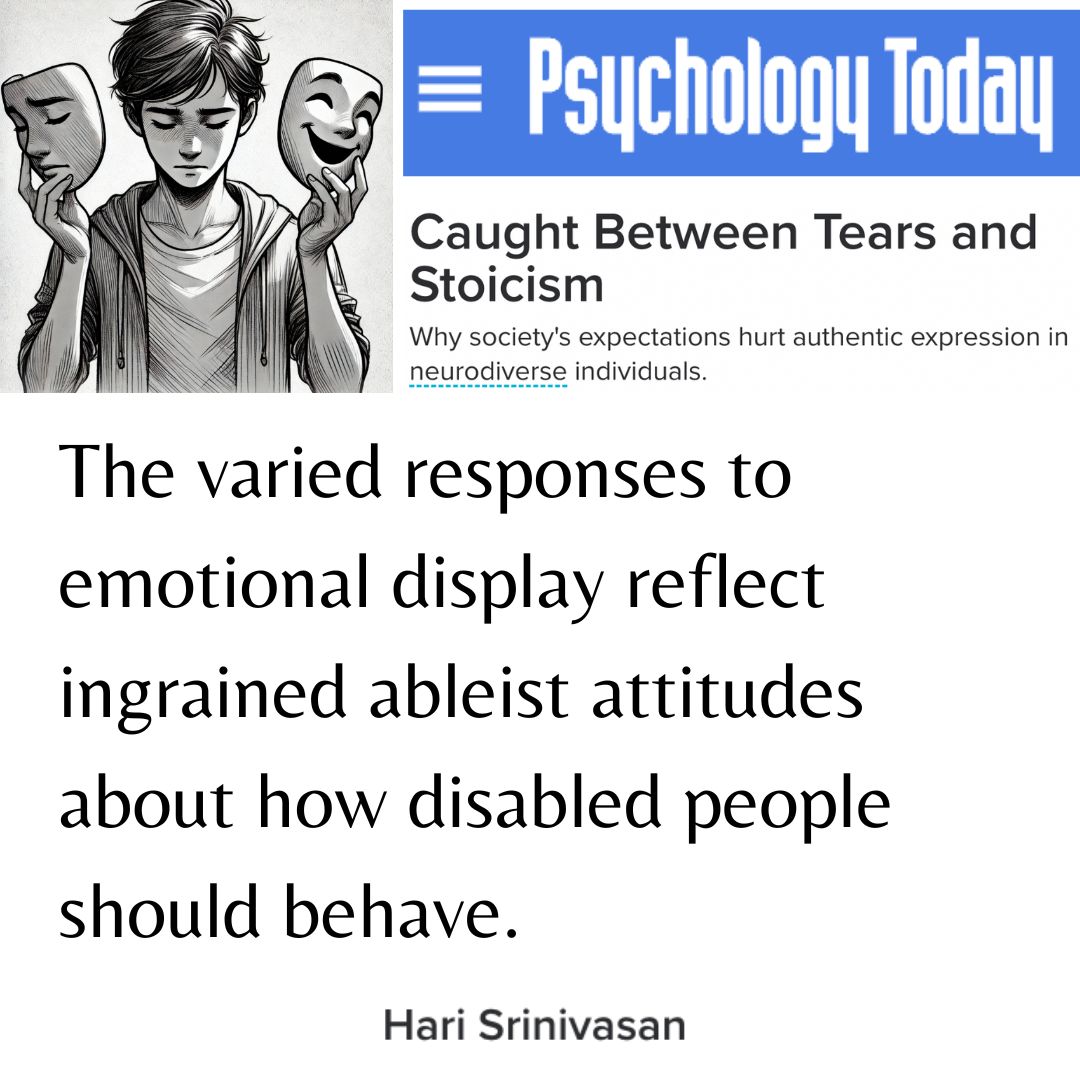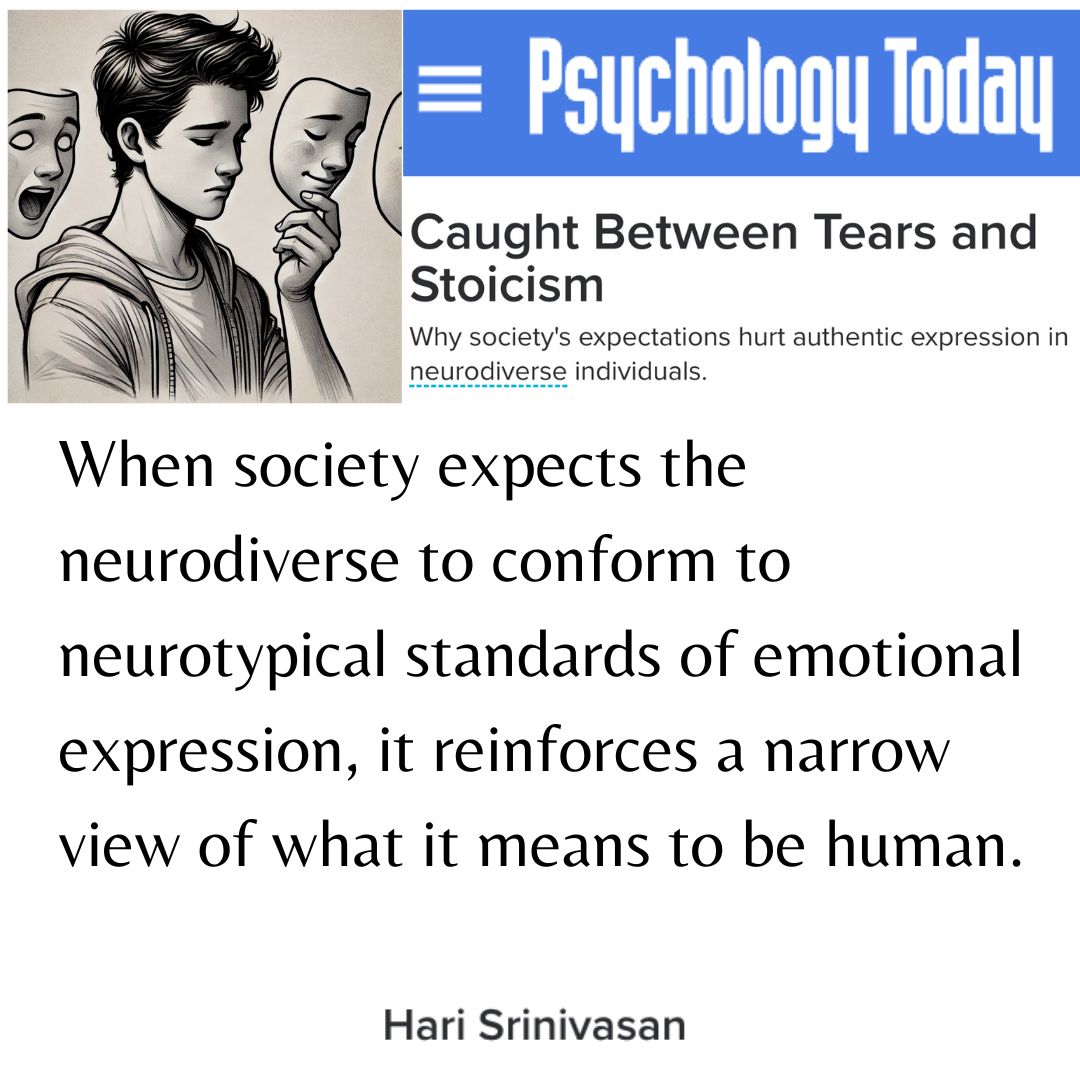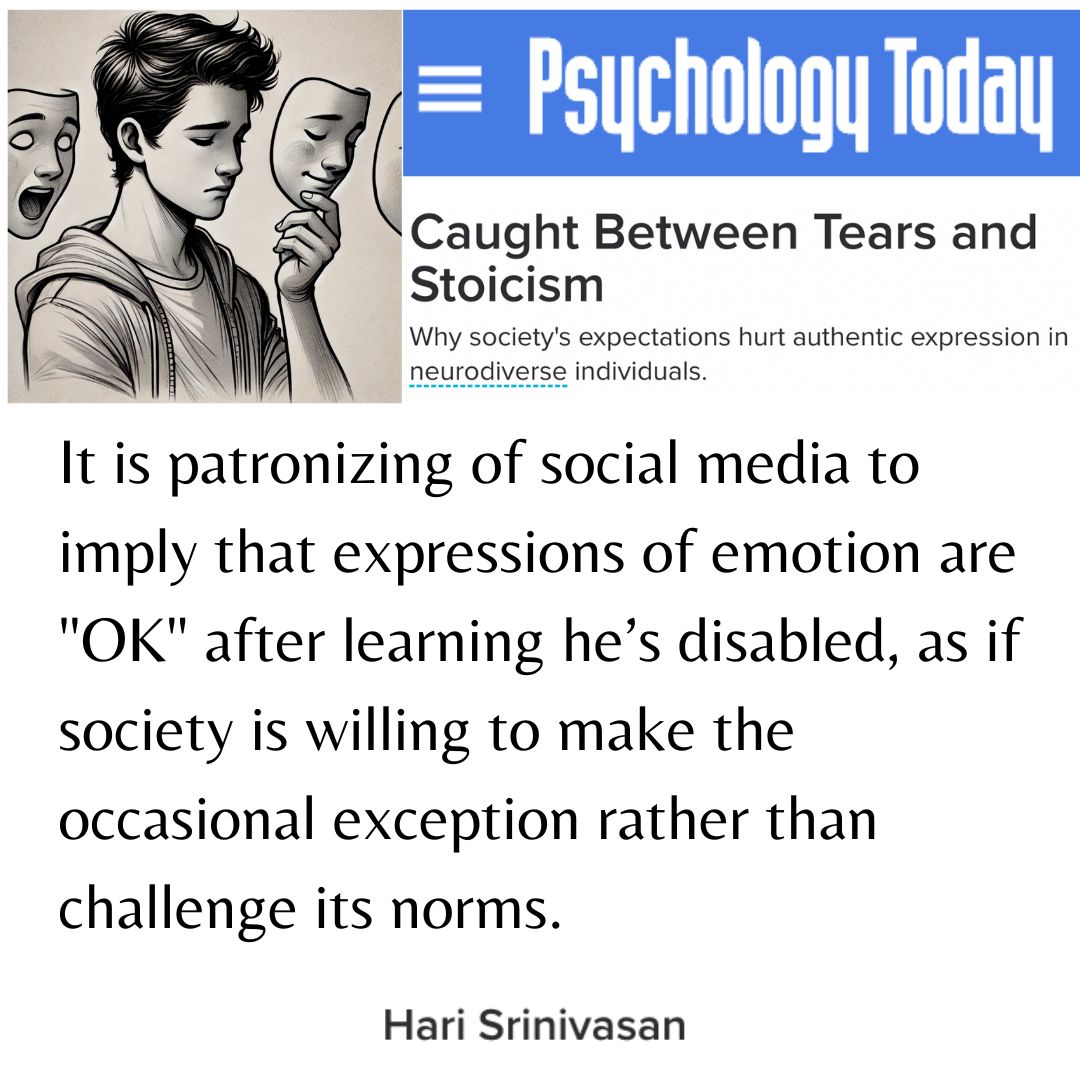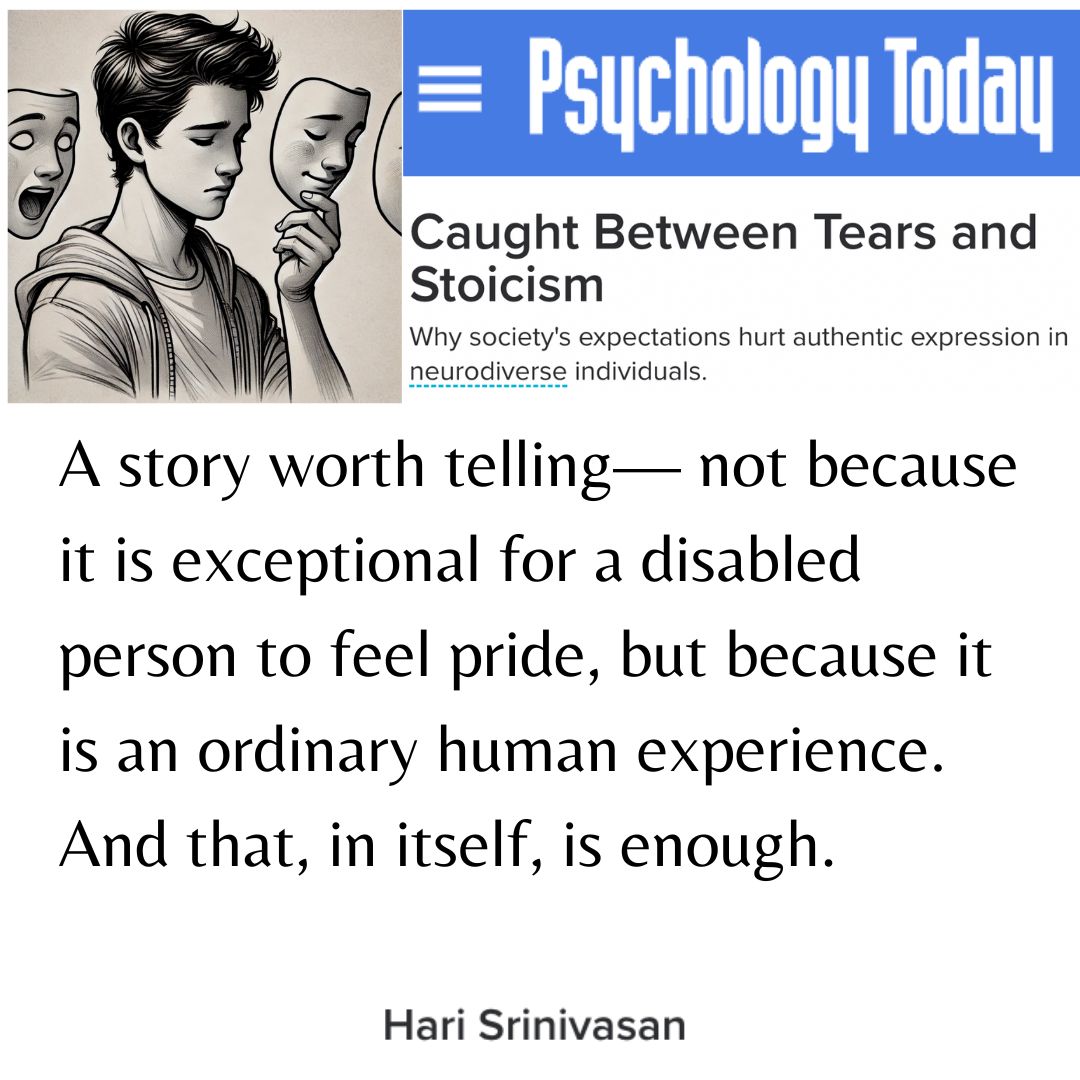Caught Between Tears and Stoicism
Caught Between Tears and Stoicism
Caught Between Tears and Stoicism
Caught Between Tears and Stoicism
Caught Between Tears and Stoicism
Caught Between Tears and Stoicism
Caught Between Tears and Stoicism
Caught Between Tears and Stoicism
Caught Between Tears and Stoicism
Caught Between Tears and Stoicism
Caught between tears and stoicism
My latest article in Psychology Today
Disabled individuals face conflicting expectations about emotional expression. Gus Walz's story reveals the bias and challenges around being authentic.
Read full article at:
https://www.psychologytoday.com/us/blog/giving-voice/202409/caught-between-tears-and-stoicism
For me, it's a reminder that listening to and trusting the experiences of Autistic people is at the heart of Autism Acceptance - and that acceptance and disability justice are at the heart of health, welllness and so many of the issues in our schools, homes, workplaces, and communities.
Your body position influences your emotional state
A study by Peper and Lin (2012) explored how body posture affects energy levels and the ability to generate positive and negative thoughts. They found that an upright posture can promote a more positive mood and energy levels, while a slumped posture can lead to increased feelings of depression.
Our bodily states and emotional reaction
Facial Feedback Hypothesis: The facial feedback hypothesis suggests that facial movements can influence emotional experiences. For example, the act of smiling can actually make people feel happier. A seminal study by Strack, Martin, and Stepper (1988) found that participants who held a pen in their mouths in a way that facilitated a smile (without being aware of smiling) rated cartoons as funnier than those who held a pen in a manner that prevented smiling. This study demonstrates the effect of facial expressions on emotional experience.
Posture and Emotion: Research on posture and emotion has shown that adopting certain body positions can influence one's emotional state. A study by Peper and Lin (2012) explored how body posture affects energy levels and the ability to generate positive and negative thoughts. They found that an upright posture can promote a more positive mood and energy levels, while a slumped posture can lead to increased feelings of depression.
Embodied Emotion: The theory of embodied emotion also supports the idea that bodily states influence emotional reactions. This perspective suggests that emotions are grounded in bodily sensations and that physical states can modulate emotional experiences. Niedenthal (2007) discusses how bodily sensations are integral to emotional processing, indicating that the body's posture, facial expressions, and actions can influence emotional states.
These studies collectively support the notion that bodily expressions and postures not only reflect our emotional states but can also influence them. The act of smiling can induce feelings of happiness, while adopting a slumped posture can contribute to feelings of depression, highlighting the intricate link between the physical body and emotional experiences.
Spectrum of Loss
Alexithymia and Autism
The term was first used in the 1970s by psychotherapist Peter Sifneos to describe a group of people who had difficulty expressing their emotions. They may also be more prone to stress-related issues and have difficulties coping with stress in general.
- Alexithymia in autistics has been associated with several negative outcomes.Social communication difficulties: Difficulty expressing emotions and interpreting the emotions of others, can interfere with social communication; which may be particularly pronounced in autistics, who already experience social communication difficulties (3).
- Reduced quality of life due to the negative impact on social relationships (4)
- Increased anxiety and depression: One study found that alexithymia was a significant predictor of depression in autistic adults (5).
- Greater risk for negative outcomes: In a longitudinal study of autistic children those with higher levels of alexithymia were found to have a higher risk for negative outcomes such as anxiety, depression, and behavioral problems over time (6).
----------
A Plain Language Version
What is Alexithymia? Alexithymia is when someone has a hard time recognizing and talking about their own emotions. They might also find it tough to cope with stress and are more likely to have stress-related issues.
History of Alexithymia The term "alexithymia" was first used in the 1970s by a psychotherapist named Peter Sifneos. He noticed that some people had difficulty expressing their emotions and gave this condition a name.
Alexithymia and Autism Studies show that alexithymia is much more common in autism. About 50% to 66% of autistics have alexithymia, compared to only about 10% of people without autism.
Effects of Alexithymia in Autism
- Social Communication Difficulties: Autistics with alexithymia have an even harder time expressing emotions and understanding others' emotions, making social interactions more challenging.
- Reduced Quality of Life: Having trouble with social relationships can lower overall happiness and satisfaction in life.
- Increased Anxiety and Depression: Research shows that alexithymia can lead to higher levels of anxiety and depression in autistic adults.
- Greater Risk for Negative Outcomes: In a long-term study of autistic children, those with higher levels of alexithymia were more likely to experience anxiety, depression, and behavioral problems as they grew up.
Understanding and addressing alexithymia in autism is important for improving social interactions, mental health, and overall quality of life.
Before you speak, ask yourself
Flat Effect in Autism
Flat affect, sometimes referred to as "flat effect," is characterized by reduced emotional expressiveness. This manifests through limited facial expressions, a lack of prosodic variation in speech, and minimal gestural communication that typically conveys emotions during social interactions. Flat affect is common among some autistic individuals, presenting unique challenges in social communication and interaction.
Manifestations of Flat Affect
Flat affect can be identified by several observable behaviors:
- Facial Expressions: Autistic individuals with flat affect might not exhibit the typical range of facial expressions, such as smiling or frowning.
- Prosodic Variation: Their speech might lack the usual variations in tone, often sounding monotone or emotionally flat.
- Gestural Communication: They might use fewer hand movements or other gestures while speaking, which are typically used to convey emotions and emphasis.
Emotional Experience vs. Expression
It's crucial to understand that flat affect does not imply a reduction in the intensity or frequency of experienced emotions. Autistic individuals with flat affect experience emotions similarly to others; however, their outward presentation of these affective states is muted. This can lead to misunderstandings in social interactions, where others might perceive them as uninterested or disengaged, even when they are emotionally involved.
Challenges in Social Interactions
The muted emotional expressiveness associated with flat affect can complicate social interactions. Nonverbal cues, such as facial expressions and tone of voice, play a significant role in how we communicate and understand each other. When these cues are diminished, it becomes harder for others to interpret the emotional states and intentions of individuals with flat affect, potentially leading to social isolation and miscommunication.
Neuroscientific Insights
From a neuroscientific standpoint, flat affect in autism can be understood through the lens of atypical neural processing and connectivity. Research suggests that autistic individuals may exhibit differences in the activation and connectivity of brain regions involved in emotion processing and expression. Key areas implicated include:
- Amygdala: The amygdala plays a crucial role in processing emotions. Studies have shown that autistic individuals may have differences in amygdala activation and connectivity, contributing to atypical emotional responses and expressions (Baron-Cohen et al., 2000; Tottenham et al., 2014).
- Prefrontal Cortex: The prefrontal cortex is involved in regulating emotional responses and social behavior. Atypical activity in this region may influence the ability to modulate and express emotions effectively (Di Martino et al., 2009).
- Mirror Neuron System: The mirror neuron system is believed to be involved in understanding and mimicking the emotions and actions of others. Differences in the functioning of this system in autistic individuals may impact their ability to express emotions through gestures and facial expressions (Dapretto et al., 2006).
Implications for Understanding and Support
Understanding flat affect and its underlying mechanisms is essential for improving social interactions and support for autistic individuals. Here are some practical steps:
- Education and Awareness: Educating peers, educators, and healthcare providers about flat affect can foster a more empathetic and supportive environment. Awareness can help mitigate misunderstandings and reduce social isolation.
- Communication Strategies: Developing alternative communication strategies, such as using clear verbal cues and seeking explicit feedback, can enhance interactions with individuals exhibiting flat affect.
- Supportive Interventions: Therapeutic interventions, such as social skills training and emotion recognition exercises, can help autistic individuals navigate social situations more effectively.
References
- Baron-Cohen, S., Ring, H. A., Wheelwright, S., Bullmore, E. T., Brammer, M. J., Simmons, A., & Williams, S. C. (2000). The amygdala theory of autism. Neuroscience & Biobehavioral Reviews, 24(3), 355-364.
- Di Martino, A., Ross, K., Uddin, L. Q., Sklar, A. B., Castellanos, F. X., & Milham, M. P. (2009). Functional brain correlates of social and nonsocial processes in autism spectrum disorders: An activation likelihood estimation meta-analysis. Biological Psychiatry, 65(1), 63-74.
- Dapretto, M., Davies, M. S., Pfeifer, J. H., Scott, A. A., Sigman, M., Bookheimer, S. Y., & Iacoboni, M. (2006). Understanding emotions in others: Mirror neuron dysfunction in children with autism spectrum disorders. Nature Neuroscience, 9(1), 28-30.
- Tottenham, N., & Gabard-Durnam, L. (2014). The developing amygdala: A student of the world and a teacher of the cortex. Current Opinion in Psychology, 17, 55-60.
Flat Affect in Autism: What It Means
Flat affect, sometimes called "flat effect," is when a person shows less emotion on their face, in their voice, and with their body movements. This is common in some autistic people. Here’s what it looks like:
- They might not smile or frown much.
- Their voice might sound the same most of the time, without much change in tone.
- They might not use many hand movements or gestures when talking.
Just because someone has a flat affect doesn’t mean they don’t feel emotions. They still have feelings, but it’s harder for others to see them.
This can make social interactions tricky. People might think someone with a flat affect is not interested or doesn’t care, even if that’s not true. Understanding flat affect helps us communicate better and connect with autistic people who show emotions differently.
===========================================================
Versions of this post: Academic/Scientific Audience & PlainSpeak for LayReader
Other articles in #PlainSpeak
Flat Effect in Autism - What it Means
Flat affect refers to a reduced emotional expressiveness, often seen in autism, which is linked to atypical neural processing and connectivity in brain regions responsible for emotion processing and expression. [read in more detail]
PlainSpeak: Flat affect means showing little to no emotion on the face or in speech, often seen in autism, due to differences in how the brain processes and shows emotions. [ Read in more detail in plain language]
Other articles in #PlainSpeak

















